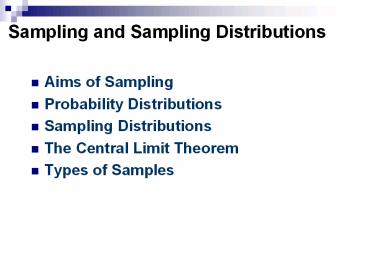Sampling%20and%20Sampling%20Distributions - PowerPoint PPT Presentation
Title:
Sampling%20and%20Sampling%20Distributions
Description:
Title: Chapter 11 Sampling and Sampling Distributions Subject: for use with STATISTICS FOR A DIVERSE SOCIETY Author: William Edward Wagner, III Last modified by – PowerPoint PPT presentation
Number of Views:198
Avg rating:3.0/5.0
Title: Sampling%20and%20Sampling%20Distributions
1
Sampling and Sampling Distributions
- Aims of Sampling
- Probability Distributions
- Sampling Distributions
- The Central Limit Theorem
- Types of Samples
2
Aims of sampling
- Reduces cost of research (e.g. political polls)
- Generalize about a larger population (e.g.,
benefits of sampling city r/t neighborhood) - In some cases (e.g. industrial production)
analysis may be destructive, so sampling is needed
3
Probability
- Probability what is the chance that a given
event will occur? - Probability is expressed in numbers between 0 and
1. Probability 0 means the event never
happens probability 1 means it always happens. - The total probability of all possible event
always sums to 1.
4
Probability distributions Permutations
- What is the probability distribution of number of
girls in families with two children? - 2 GG
- 1 BG
- 1 GB
- 0 BB
5
(No Transcript)
6
How about family of three?
Num. Girls child 1 child 2 child 3
0 B B B
1 B B G
1 B G B
1 G B B
2 B G G
2 G B G
2 G G B
3 G G G
7
Probability distribution of number of girls
8
How about a family of 10?
9
As family size increases, the binomial
distribution looks more and more normal.
10
Normal distribution
- Same shape, if you adjusted the scales
B
C
A
11
Coin toss
- Toss a coin 30 times
- Tabulate results
12
Coin toss
- Suppose this were 12 randomly selected families,
and heads were girls - If you did it enough times distribution would
approximate Normal distribution - Think of the coin tosses as samples of all
possible coin tosses
13
Sampling distribution
- Sampling distribution of the mean A
theoretical probability distribution of sample
means that would be obtained by drawing from the
population all possible samples of the same size.
14
Central Limit Theorem
- No matter what we are measuring, the distribution
of any measure across all possible samples we
could take approximates a normal distribution, as
long as the number of cases in each sample is
about 30 or larger.
15
Central Limit Theorem
- If we repeatedly drew samples from a
population and calculated the mean of a variable
or a percentage or, those sample means or
percentages would be normally distributed.
16
Most empirical distributions are not normal
U.S. Income distribution 1992
17
But the sampling distribution of mean income over
many samples is normal
Number of samples
Number of samples
18 19 20 21 22
23 24 25 26
Sampling Distribution of Income, 1992 (thousands)
18
Standard Deviation
- Measures how spread out a distribution is.
- Square root of the sum of the squared deviations
of each case from the mean over the number of
cases, or
19
Example of Standard Deviation
2
2
20
Standard Deviation and Normal Distribution
21
Distribution of Sample Means with 21 Samples
10 8 6 4 2 0
S.D. 2.02 Mean of means 41.0 Number of Means
21
Frequency
37 38 39 40 41 42 43 44 45 46
Sample Means
22
Distribution of Sample Means with 96 Samples
14 12 10 8 6 4 2 0
S.D. 1.80 Mean of Means 41.12 Number of Means
96
Frequency
37 38 39 40 41 42 43 44 45 46
Sample Means
23
Distribution of Sample Means with 170 Samples
30 20 10 0
S.D. 1.71 Mean of Means 41.12 Number of Means
170
Frequency
37 38 39 40 41 42 43 44 45 46
Sample Means
24
The Central Limit Theorem
- If all possible random samples of size N are
drawn from a population with mean x and a
standard deviation s, then as N becomes larger,
the sampling distribution of sample means becomes
approximately normal, with mean x and standard
deviation .
25
Sampling
- Population A group that includes all the cases
(individuals, objects, or groups) in which the
researcher is interested. - Sample A relatively small subset from a
population.
26
Random Sampling
- Simple Random Sample A sample designed in such
a way as to ensure that (1) every member of the
population has an equal chance of being chosen
and (2) every combination of N members has an
equal chance of being chosen. - This can be done using a computer, calculator, or
a table of random numbers
27
Population inferences can be made...
28
...by selecting a representative sample from the
population
29
Random Sampling
- Systematic random sampling A method of sampling
in which every Kth member (K is a ration obtained
by dividing the population size by the desired
sample size) in the total population is chosen
for inclusion in the sample after the first
member of the sample is selected at random from
among the first K members of the population.
30
Systematic Random Sampling
31
Stratified Random Sampling
- Proportionate stratified sample The size of the
sample selected from each subgroup is
proportional to the size of that subgroup in the
entire population. (Self weighting) - Disproportionate stratified sample The size of
the sample selected from each subgroup is
disproportional to the size of that subgroup in
the population. (needs weights)
32
Disproportionate Stratified Sample
33
Stratified Random Sampling
- Stratified random sample A method of sampling
obtained by (1) dividing the population into
subgroups based on one or more variables central
to our analysis and (2) then drawing a simple
random sample from each of the subgroups































